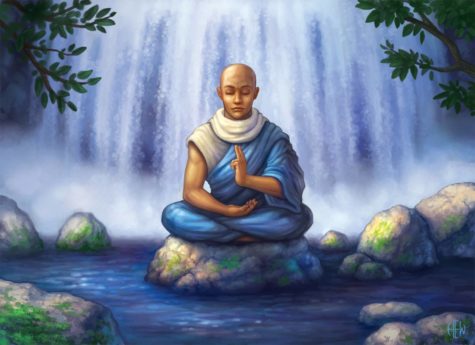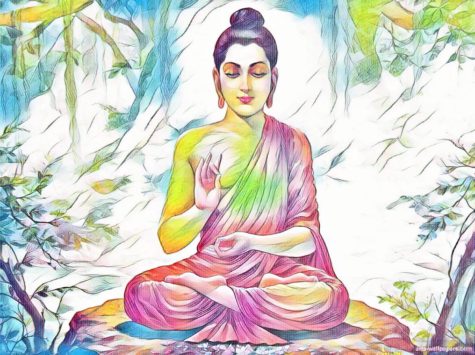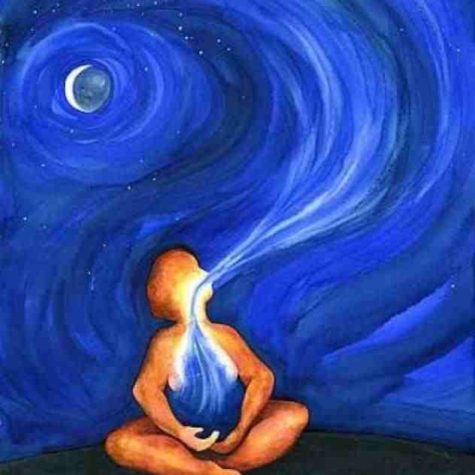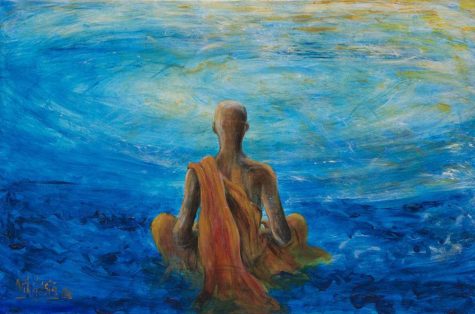How-To Basics
This is a transcript of an interview with author Jurgen Ziewe about The Ten Minute Moment by Evita Ochel. I found it interesting and informative, and so am sharing it here:
- Evita:
Your book The Ten Minute Moment shares your personal journey of a solitary meditation retreat in a remote log cabin in the mountains of Scotland. What is the greatest impact that this experience had on you, as you see it today?
- Jurgen:
The profound experience mentioned in the book formed a tipping point, which turned out to be irreversible. There is no going back. Now everything existing in the present moment is of equal importance, because every appearance is supported by the all pervading reality of stillness and unity. There is no getting away from the fact that all reality — and no matter how this reality presents itself in my daily life — is underpinned by pervading stillness against which everything else plays out, which of course is always transient.
I discovered I could no longer ignore or turn my back to this resilient fact. The reality of it is just too overpowering, too obvious. I only have to look at anything, any object at all, to find proof of it, to see this unity. Everything that exists, simply by my awareness of it, convinces me of this profound fact. I knew, that from this moment onwards, this stillness and profound peace was against which everything else had to be evaluated and considered.
- Evita:
Given your vast experiences with meditation over the years, how would you describe what meditation is?
- Jurgen:
To me meditation is simply accepting that I am already one with all. Meditation is the surrendered resting in this overwhelming fact. So I don’t have to do anything special, just accept this reality. With this acceptance comes the security that I do not need to go anywhere or aim for anything. I simply surrender to its fulfillment. Knowing that I am already here, united with my source I simply rest in and relish the reality of it. There is nowhere else to go. I am already where I am meant to be. To me that is meditation.
However, should I consider a traditional meditation technique when resting in my chair, such as focusing on the light or a mantra, I then simply take the position of the light and rather than focusing on it, I radiate out from it into the universe surrounding me, because I am already the light or the mantra.
- Evita:
There are many types of meditation talked about in our society and beginners are often confused about what kind of meditation to do. What is your recommendation in this regard?
- Jurgen:
To me Meditation is an individual contract each one of us makes with their own source, God or their Higher Self; a contract which is simply based on love. I realize that some people may take a different route, and that is why I think it has to be an individual path. With billions of people there are billions of meditation techniques. The good news is that the moment I direct my attention within, I develop more of a sense of what is good for me and what is not. To me, the meditation is to find the best way to open a channel of communication to the inner teacher.
- Evita:
Many people who attempt meditation are often also frustrated by the constant chatter of thoughts expressed by the mind, which they cannot seem to turn off or escape from. What is your advice on how to overcome this?
- Jurgen:
Show kindness to your thoughts. When kindness and love rise in your awareness these feelings are more powerful than thoughts. Giving preference to appreciation, gratitude and love makes meditation and the focus much easier, more pleasurable and more rewarding. I see thoughts like boats on the ocean, where the ocean is love. When love becomes the carrier of my meditation then my thoughts become like sailing boats on the ocean’s surface, submitting to the carrying elements. If the ocean is calm my thoughts are calm and pacified, and my meditation will be enjoyable.
But sometimes thoughts come along which need attention. Some thoughts are not really worthwhile and I simply let them wither by not paying them any attention. Others are powerful and crave for every ounce of awareness I can give. Their challenge makes me dig deep until I reach the level of wisdom. So sometimes these big compelling thoughts can lead me to a much deeper level of awareness. I know when I have reached this level because it is like a crystal lake of reflection, with its mirror surface it reflects my thought from all sides. I use kindness and understanding in my reflection and never condemn. I let no aspect be unattended to or rejected, and show all of its aspects the greatest respect. Because, deep down I know I am the parent of my thoughts, which I recognize as my own children. Like a good father I guide my thoughts into the clear light of understanding, then peace will result or a clear plan of action will emerge.
Then there are thoughts that are like warm honey from a flower of wisdom and knowing deep within. They are the gift of inspiration which are offered to enrich my life and the lives of others. I show my gratitude to these offerings and store them in my soul for later use.
Then there can be habitual or addictive thoughts trying to steal my attention, I simply stop feeding these until they wither and instead favour the reality of ‘what is’ and the unspoken moment which doesn’t require thought. If I do not succeed I simply rest my awareness on my breath or any other feeling I can devote my love to until I find rest and calm awareness.
- Evita:
Intentional silence, solitude and stillness to experience pure being have become increasingly rare in our world today. Why are these experiences important to prioritize and cultivate in our lives?
- Jurgen:
Real silence, solitude and stillness are only found once the self referential chatter of our mind has stopped. The mind is a Perpetuum Mobile, always feeding and needing to be fed, always striving for answers while continually remaining unsatisfied. We may turn to solitude in nature and yet the mind may be churning out its constant chatter. Real solitude is to be found when this chatter is disrupted by something that takes our attention into a completely new direction, which is inaccessible to the mind. This is actual experience, which enriches the heart and our feeling.
Instead of channeling our input through our senses via the mind, we channel our input through the heart. Instead of hearing and seeing the bird in the tree, we identify with and ‘become’ the bird in the tree by sending it our love and experience its existence. After all, in reality, consciousness is not limited to our own body and self, but it is everywhere we look at and place our attention on. The moment our attention is placed on the all surrounding ‘us’ we experience true silence and stillness because there is no longer anything the limited mind can divide us from. There is only the experience of pure being.
Sometimes we need to create space in our lives to disrupt the constant flow and feedback of information. To be alone with our thoughts and our self is just as important for our mind and soul, as a good diet and exercise is for our body. Daily, regular meditation can give us this space even in the busiest metropolis and provides the nourishment for our soul.
- Evita:
At the end of the book you share 12 markers of an awakened life that you noticed have manifested in your life. Which one, would you say, has been the most instrumental in changing who you are and how you live your life today, and why?
- Jurgen:
Number two. The constant feeling of being home. This is the most persistent experience because there is no longer such a thing as an outside world. I am always home wherever I am, even in the biting cold of the winter storm, because that too is the experience of what I am. Wherever I want to be I am already here and that fills me with great peace and satisfaction. My greatest joy is the constant experience that I am Here, that I have been chosen and blessed simply to be alive.
- Evita:
What do you see today, as the greatest obstacle that humans of this Earth reality face to advance their spiritual evolution, and what can be done about this?
- Jurgen:
Reality is simple, it’s just that we are so engrossed in our mental interpretation of it that we have lost our natural means of communication with that which simply is. Present reality is the great leveler, there for all, from insect to human, and we don’t need the mind to access it. We simply need to be and live in the acceptance of our being. The most natural way to do so is to surrender to it without thinking about it. The moment we surrender, reality makes us a conscious part of its universal being and bliss.
How do we surrender when we are so accustomed to and in need of control, when our first line of confronting a situation is via our emotions, instincts, and conditioned behavior?
The first action would be to surrender to any given situation via our heart first, by accepting it, appreciating the presence of its reality. Accepting here-now reality and the way it presents itself by sidestepping the ego creates space for intuition to come to the fore and guide our interaction. Acceptance creates space and makes it apparent that we are an intrinsic part of the challenge. This offers us a greater view of the situation from within and we are able to appreciate the position of others. Instead of controlling a situation on a whim we are adapting to its inherent nature, which is not blindsided by self interests. We derive strength and power from an underlying current of what is right and true, which will give us the authority and strength to act in harmony with its inherent laws and make our decisions with clarity.
When we wake up to this simple and amazing fact that stillness underpins all reality and gently and with kindness go about our daily business, we calmly take stock and begin to understand what needs to be done. We begin to see that that which we think is us, is in fact only a minuscule part of the whole. Instead of seeing the world only in relation and separation to ourselves, we begin to experience the world around us as a whole and as our home. Once this realization manifests in our daily life, we begin to act in a way which benefits the whole. By asking “how can I serve?” we benefit ourselves because we are part of the vast reservoir we are serving.
- Evita:
Thank you so much Jurgen for sharing your time, love and wisdom with us here today. Your message is always shared with such an immense amount of gentleness and compassion, yet it guides us to the core of truth like a laser, with utmost focus and clarity.
Here is an excerpt from an interview with Jurgen Ziewe, in which he talks about meditation. I found it interesting and helpful, so am sharing this here:
- Question:
Meditation can mean different things to different people, so what is your exact definition of “meditating”?
- Answer:
To me meditation means living in the present or as Eckhard Tolle says, “living in the now”. Meditation begins by forming a habit that allows you to put yourself in control of your thoughts, which means if you focus during meditation on the light, a mantra or anything else and thoughts pop up you simply say, “OK, now lets go back to the focus” without any force whatsoever.
It is the continuous “OK, now lets go back to the focus” which is the most powerful aspect of meditation not necessarily the object of the meditation, such as the light or the mantra and can almost be anything.
What you are doing is conditioning your mind into following your intent. It’s a bit like training a dog. Once you have achieved this you simply focus on consciousness during meditation and during your daily life. You’ll gradually find yourself living more and more in the present or in the “Now”. Your focus becomes much better too as a result and your life more rewarding, blissful even. There is no reason why you cannot meditate whilst out of the body which can have spectacular results.
- Question:
On the topic of meditating, do you know what is an optimal way to become more able at perceiving and expanding with/through the consciousness? I have been attempting for a while to do this, but without much success.
- Answer:
A common misconception is that meditation needs somehow a lot of effort or discipline. Quite frankly, the opposite is the case. It’s more a matter of favoring focus on whatever you are meditating on instead of the thoughts which inevitably arise. Thoughts are OK, as long as they don’t dominate us.
Thoughts can be great fun and we have developed a whole industry creating entertainment for our thoughts. The trick is to be able to decide which thoughts we want or whether we want them at all and instead enjoy the underlying serenity of the present moment without thought distraction.
Meditation to me is habituating the mind so it finally naturally follows our intent. It is not to control our mind or dominate it. As such meditation is a beautiful experience, because we never reject our thoughts we just regard them like our children we love, but who we won’t allow to tyrannise us.
The aim of the meditation should be: “OK, now lets gets get back to our focus”, it is this process which is important not the focus itself such as light, sound or mantra. Once focus follows your intent effortlessly your attention simply lingers quite naturally on reality, the moment, the present, God or whatever you wish to call it.
Once we have freedom from the compulsion of thinking we simply focus our attention on awareness or consciousness itself without any attributes dictated by our thinking or imagination, which means we live in the present and become aware of what makes the present. We live in reality.
- Question:
Many chant different Names of God and mantras. The specific thing they chant does mean something because they are utilizing that specific Name of God/mantra.
- Answer:
There is often a misunderstanding about the use of mantras. Some people think just by chanting and repeating the mantra they are getting closer to the higher consciousness or God. I found this to be an illusion. When seen from a higher level such chants look more like a marble clattering around endlessly in an empty jam jar without ever leaving it’s confines.
Often the chanter even thinks about other things while chanting like some robot or tape recording, clearly without the heart being in any way connected. This is as pointless as planting a crystal in the ground and expecting it to grow into an oak tree.
As pointed out previously the mantra can be a powerful vehicle for transporting consciousness into subliminal levels, but we will have to engage with the mantra. The most effective way is by totally surrendering to or identifying with the mantra. This way the mantra is no longer an object of our meditation but it’s manifestation with which we will have merged.
- 1.
Every sincere effort is registered in the divine consciousness. Your duty as a devotee is to accept whatever [God] sends you — and, for that matter, whatever He doesn’t send. God alone knows what past karma keeps you from perceiving Him right now. He may want you to finish up your karma in this life, before He gives you eternal bliss in Him.
- 2.
Do not be anxious if you don’t have meditative experiences. The path to God is not a circus! Don’t even be anxious about such fruits of meditation as inner joy and peace. Everything will come in God’s time. Meanwhile, consider meditation, too, as a form of karma yoga: action without desire for the fruits of action. Meditate above all to please God, not yourself.
- 3.
In meditation, you must go beyond thought. As long as you are busy thinking, you are in your rational mind, on the conscious plane. When you sleep and dream, you are on the subconscious plane, and in your astral body. And when your mind is fully withdrawn in superconsciousness, it becomes centered in the bliss of the spine. You are then in your ideational, or causal, body. That is the level of the soul’s existence.
- 4.
Don’t waste the perception of God’s presence, acquired in meditation, by useless chatting. Idle words are like bullets: they riddle the milk pail of peace. In devoting time unnecessarily to conversation and exuberant laughter, you’ll find you have nothing left inside. Fill the pail of your consciousness with the milk of meditative peace, then keep it filled. Joking is false happiness. Too much laughter riddles the mind and lets the peace in the bucket flow out, wasting it.
- 5.
Meditate regularly, and you will find a joy inside that is real. You will then have something you can compare to sense pleasures. That comparison will automatically make you want to forsake your sorrow-producing bad habits. The best way to overcome temptation is to have something more fulfilling to compare it with.
- 6.
Never count your faults. Just think whether you love God enough. He doesn’t mind your faults. He minds your indifference.
- 7.
Many people meditate till they feel a touch of peace, but jump up then and leave their meditation for their activities. That’s all right, if you have important work waiting for you, for it is always better to meditate before any activity, that you may feel at least some peace as you work. Whenever possible, however, sit for a long time after your practice of the techniques. That is when the deepest enjoyment comes. Intuition is developed by continuously deepening that enjoyment, and, later on, by holding on to its calm aftereffect.
- 8.
God answers all prayers. Restless prayers, however, He answers only a little bit. If you offer to others something that isn’t yours to give, won’t that be a merely empty gesture? If you pray to God, similarly, but lack control over your own thoughts, that prayer will be without power. Thoughts and feelings, both, must be focused when you pray. Otherwise God will meet your little trickle with another trickle of His own! He will dole His answers out to you in a teaspoon. Too often, prayer is more like the halfhearted mumbling of a beggar than the confident, loving demand of a friend.
- 9.
You won’t find God by making constant excuses: for example, saying, “When I find a quiet place, I will meditate.” That is not at all the way to get there! If you tell yourself, however, “Right now I will plunge into deep meditation!” you can be there in a moment. When you are really sleepy, you have no difficulty in sleeping no matter where you are. When a person is in love, he finds no difficulty in thinking of his beloved; rather, it is difficult not to think of her, even to the point of ignoring his work. Be in love with God! It is easy to meditate deeply, when your love for Him is deep enough.
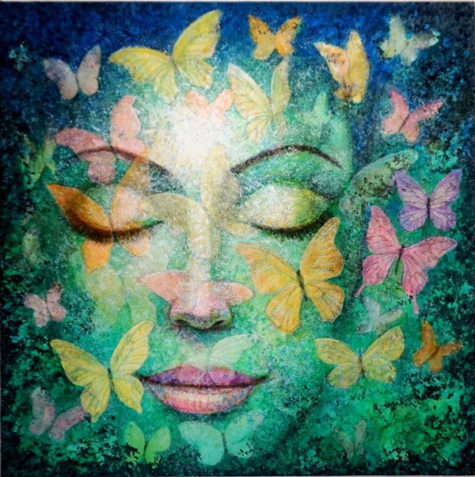
When people start to meditate or to work with any kind of spiritual discipline, they often think that somehow they’re going to improve, which is a sort of subtle aggression against who they really are.
It’s a bit like saying, “If I jog, I’ll be a much better person.” “If I could only get a nicer house, I’d be a better person.” If I could meditate and calm down, I’d be a better person.”…
But loving-kindness–maitri–toward ourselves doesn’t mean getting rid of anything. Maitri means that we can still be crazy after all these years. We can still be angry after all these years. We can still be timid or jealous or full of feelings of unworthiness. The point is not to try to throw ourselves away and become something better. It’s about befriending who we are already.
The ground of practice is you or me or whoever we are right now, just as we are. That’s the ground, that’s what we study, that’s what we come to know with tremendous curiosity and interest.
~Pema Chödrön
The term mantra should be familiar to most readers. It is usually associated with sounds or words that when spoken or sung, evoke a particular magical power or energy. Two of the best-known mantras are AUM or Om, The term mantra is derived from the sanskrit root “man”, which means, ‘to think’. Thus the uttered sound is merely an aid to the focusing and direction of thought, and initiates of Tantrika regard the different types of mantra as vehicles for articulating spiritual energy as sound.
For example, there are ‘seed’ mantras such as Hrim, Krim and Srim. which represents the quintessence of the power of particular deities; there are also mantras which are based on texts, and have symbolic, rather than literal meanings, and, as in most cultures, spells and mnemonic formula.
In tantrik ritual, or Puja, the seed mantras are pronounced from the diaphragm, the throat, rolled around the tongue and finally closed off with the nasal sound “m”. Mantras may be uttered ‘in silence’, as it were, and be none the less effective.
Similarly, Cherokee shaman songs may be sung or thought, and remain effective. According to one medicine man, the same song could be used for ‘every purpose there is’, adding that it is ‘the intention of the heart, and the knowledge, that really count.’
In techniques such as japas (recitation), the practitioner repeats a sound or phrase repeatedly, moving eventually from spoken speech to ‘silent’ speech. The original words may degenerate into a meaningless mush, but again, it is the rhythm which whirls the practitioner’s brain towards ecstasy – recognisable by the perception that it is no longer you who chants, but that the chant chants itself through you.
Again, don’t take my word for it, have a go yourself. You don’t have to use a phrase which necessarily has any ‘mystical’ significance – it’s the rhythm and momentum that’s important – try it with ‘My Mum’s Monkey Makes Many Mistakes’ for about half an hour a day for a few weeks, and see where it takes you.
From: The Magical Use of Voice
Mantra art by: Stephanie Smith
Here is a simple tutorial and a simple mantra for a meditation technique. It is very similar to the Transcendental Meditation technique, and if you have a different mantra that you’d like to use, feel free to do so.
The instruction is from the book Deep Meditation by Yogani. The book is a quick and easy read, a slim 100-page book in pretty big type-and at a little under ten bucks, it’s also a bargain. And while I recommend you buy a copy, I thought I’d provide ten key points from the book which are listed below.
1. For most people, twenty minutes is the best duration for a meditation session. It is done twice per day, once before the morning meal and the day’s activity, and then again before the evening meal and the evening’s activity.
2. A word on how to sit for meditation: The first priority is comfort. It is not desirable to sit in a way that distracts us from the easy procedure of meditation.
3. For our practice of deep meditation, we will use the thought I AM. This will be our mantra. We can also spell it AYAM.
4. While sitting comfortable with eyes closed, we’ll just relax. We will notice thoughts, stream of thoughts. That is fine. We just let them go without minding them. After about a minute, we gently introduce the mantra.
5. Whenever we realize we are not thinking the mantra inside any more, we come back to it easily.
6. As soon as we realize we are off into a stream of thoughts, no matter how mundane or profound, we just easily go back to the mantra. Like that. We don’t make a struggle of it. The idea is not that we have to be on the mantra all the time.
7. Thoughts are a normal part of the deep meditation process. We just ease back to the mantra again. We favor it. Deep meditation is going toward, not pushing away from.
8. No struggle. No fuss. No iron willpower or mental heroics are necessary for this practice. All such efforts are away from the simplicity of deep meditation and will reduce its effectiveness.
9. When we realize we have been off somewhere, we just ease back into the mantra again. We are reading it inward with our attention to progressively deeper levels of inner silence in the mind.
10. This cycle of thinking the mantra, losing it, and coming out into a stream of thoughts is a process of purification. It is very powerful, and will ultimately yield a constant experience of inner silence in our meditation and, more importantly, in our daily activity.
Breath is life and change, a basic connection between the inner and the outer. It is a flowing bridge between life and death. Every breath is rebirth, inspiration, a letting go of the old. Breathing is a constant source of energy, a continuous affirmation.
Change your breathing and you will think differently, and this change can be created by choice because breathing is one of the few bodily functions that can be voluntary or automatic.
Here is an easy breathing exercise:
Fix your concentration in the middle of the forehead. See a radiant jewel there. Watch and observe what happens as you inhale through your nose – pulling your diaphragm in, and exhale through your nose – pushing your diaphragm out.
Repeat this process 6 or 10 times.
- What happened?
- How do you feel?
1. Sit on the forward third of a chair or a cushion on the floor.
2. Straighten and extend your spine, keeping it naturally upright, centering your balance in the lower abdomen. Push your lower back a little forward, open your chest, and tuck your chin in slightly, keeping the head upright, not leaning forward, or backwards, or to the side. Sway your body gently from left to right in decreasing arcs, until you naturally come to a point of stillness on your cushion.
3. Keep your eyes on the floor at a 45-degree angle, neither fully opened nor closed, and gaze naturally about 3 to 4 feet in front of your body. If the eyes are closed, you may want to start to daydream or visualize things. If your eyes are open wide open, your mind will scatter.
4. Keep your lips and teeth together with your tongue resting against the roof of your mouth.
5. Place your hands on your lap with the right palm up and your left hand (palm up) resting on your right hand, thumb tips lightly touching, forming a vertical oval. This is the mudra of zazen, in which all phenomena are unified. Rest this mudra with the blade of your hands against your abdomen, a few inches below the navel, harmonizing your own center of gravity with the mudra.
6. Take a deep breath, exhale fully, and then take another deep breath, exhaling fully. Let your breathe settle into its natural rhythm.
7. Keep your attention on your breath. When your attention wanders, bring it back to the breath again and again — as many times as necessary!
8.. Practice this Zen Meditation every day for at least ten to fifteen minutes (or longer).


